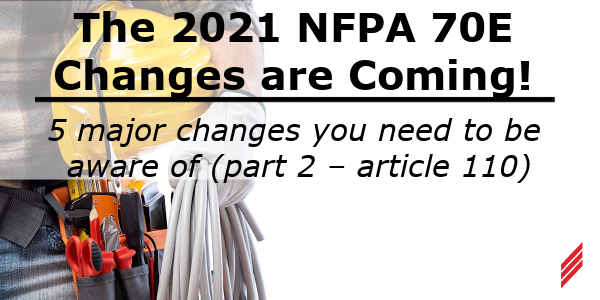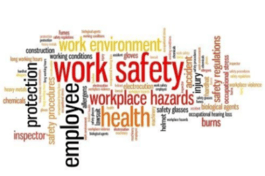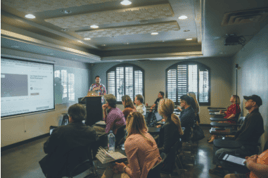The 2021 NFPA 70E Changes are Coming! 5 Major Changes You Need to be Aware of (Part 2 – Article 110)
by Scott King, PMP on Nov 12, 2020 10:30:00 AM

Another 3 years has passed and it’s time for another NFPA 70E update. This new update will be the 2021 version. This document will provide a brief summary of the proposed changes. Please note that these changes have not yet been fully adopted, but they provide a fair representation of what’s likely going to be in the final version.
I was fortunate to get a sneak preview to the proposed changes by attending a webinar in July 2020 hosted by Jim Phillips of brainfiller. Jim is a Technical Committee Member of the NFPA 70E Standard for Electrical Safety in the Workplace and is well respected in the electrical industry.
I have written a series of blogs on the proposed changes, organized by Article:
Existing text from 2018 is provided, with changes shown as either strikethrough for deletions or in RED for changes.
Changes to Article 110 (General Requirements for Electrical Safety Related Work Practices):
This article is lined up for a considerable reorganization. Like most standards such as 70E or the NEC for example, they evolve and develop over time. Therefore, during this latest round of review, it was determined that other parts of 70E such as Article 105, 120 and 130 had sections that really should be part of the “General Requirements” section of the guideline (e.g. Article 110):
- The current 2018 version has seven (7) sections of Article 110. 110.1 thru 110.7.
- These sections will remain but will be reorganized to sections 110.5 thru 110.11.
- 5(A) Electrical Safety Program was previously in section 110.1(A).
- All references to safety management systems and standards was removed and relocated to an annex.
- Informational Note 2 was modified to reference Annex P to implement an electrical safety program within an employer’s occupational health and safety management system but aligning with this standard.

- 5(H)(2) Human Error was previously in section 110.1(H)(2); It was added in the 2018 version, but it’s clarified in 2021 with added language since it was too broad. “the risk assessment procedure shall address the potential for human error and its negative consequences on people, processes, the work environment, and equipment” “relative to the electrical hazards in the workplace". If you accredit most of the electrical safety issues historically, human error is probably the leading cause.
- “110.5(K) Electrically Safe Work Policy”. New to 2021. If you have an electrical safety program, you now need an “electrically safe work condition policy” that complies with 110.5.

- Compares with Article 120 ensuring it becomes part of the safety program.
- 6(A)(3) Additional Training and Retraining was previously in section 110.2(A)(3). The words “Additional Training” was added since the section mentions it.

- 6(A)(4) Type of Training was previously in section 110.2(A)(4). Added that “training can include interactive electronic or interactive web-based”. Ironically, this addition occurred long before Covid-19. As we all know, a good deal of our communications consists of interactive electronic and web-based.
- 3 Host and Contract Employer’s Responsibilities was previously in section 110.3.
- 7(C) Documentation previously 110.3(C) added an informational note: “On multi-employer work sites, more than one employer can be responsible for identifying hazardous conditions and creating safe work practices”. In other words, everybody is responsible for safety not just the mother ship of a very large organization.
- 8 Test Instruments and Equipment previously in section 110.4. Section (A) Testing removed the words “operating at voltages equal to or greater than 50 volts” was replaced with “where an electrical hazard exists”. This was replaced because there are more hazards than just the shock hazard (e.g. arc flash and arc blast).
- 5(A) Electrical Safety Program was previously in section 110.1(A).
- Other sections of Article 105, 120 and 130 will be moved to become 110.1 thru 110.4.
- These include: Article 105.4 Priority becoming Article 110.1

- Why was this moved? To emphasize its use. The single most important factor in all cases is “eliminating the hazard” when it comes to safety related work practices. Makes sense, right? If you recall, elimination is the risk control method listed on the top of the hierarchy of risk control methods in 110.5(H)(3) previously 111.1(H)(3). This was added as an informational note referencing hazard elimination as being top priority. Also, see Annex F “Risk Assessment and Risk Control” gives examples of hazard elimination. Additionally, the note provides reference to Article 120 to establish an electrically safe work condition.
- New informational note 2: That “an electrical safe work condition is a state wherein all hazardous electrical conductors or circuit parts to which a worker might be exposed are placed and maintained in a deenergized state, for the purpose of temporarily eliminating electrical hazards. See Article 120 for requirements to establish an electrically safe work condition for the period of time which the state is maintained. See informative Annex F for information regarding the hierarchy of risk control and hazard elimination”.
- Another informational note was added 110.1(I)(1) for “Job Safety Planning” with a sample checklist in Annex I. Checklist are very important and they do help when eliminating the hazards. It’s better to know there is a problem first-hand rather than after the fact for the problem to occur.

- Why was this moved? To emphasize its use. The single most important factor in all cases is “eliminating the hazard” when it comes to safety related work practices. Makes sense, right? If you recall, elimination is the risk control method listed on the top of the hierarchy of risk control methods in 110.5(H)(3) previously 111.1(H)(3). This was added as an informational note referencing hazard elimination as being top priority. Also, see Annex F “Risk Assessment and Risk Control” gives examples of hazard elimination. Additionally, the note provides reference to Article 120 to establish an electrically safe work condition.
- Article 120.2(A) General becoming Article 110.2
- Article 130.2 Electrically Safe Working Condition becoming Article 110.3
- By moving this article, it gets prioritized to de-energize which is part of an Electrically Safety Program and should be mentioned before lockout requirements. Another reason for the move is that Article 130 focuses more on the “work” related to an electrical hazard.
- This is not the procedure for establishing an electrically safe work condition (The How) but its information about the safe work condition when its required (The When). Such as an employee being within the limited approach boundary and if they “interact” with equipment which has an increased likelihood of injury from an exposure to an arc flash hazard. The likelihood exists whether “exposed” parts or not if there is “interaction”.
- Article 130.2(A) Energized Work becoming Article 110.4.
- A new section Article 110.12 is being added “Equipment Use”.
- “Equipment shall be used in accordance with the manufacturer’s instructions”. We all are guilty of this! I never read the instructions. I just try to figure it out myself. However, when it comes to “Electrical Safety”, it’s probably a good idea to read the instructions.
- These include: Article 105.4 Priority becoming Article 110.1
I realize there is a good deal of information here to digest but I hope this gives you an idea of what’s to come. I want to thank Jim Phillips for helping us all learn more about the proposed NFPA 70E 2021 changes. As always, if you have any questions or want to learn more, please feel free to reach out to me anytime.
About the Author:
Scott King is the VP & National Director of Electrical Safety Services. Scott has been with Hallam-ICS for over 30 years. Scott and his team have been conducting power system studies for over 15 years.
Read My Hallam Story
About Hallam-ICS:
Hallam-ICS is an engineering and automation company that designs MEP systems for facilities and plants, engineers control and automation solutions, and ensures safety and regulatory compliance through arc flash studies, commissioning, and validation. Our offices are located in Massachusetts, Connecticut, New York, Vermont and North Carolina and our projects take us world-wide.
You May Also Like
These Related Stories

The 2021 NFPA 70E Changes are Coming! 5 Major Changes You Need to be Aware of (Part 1 – Article 100)

The 2024 NFPA 70E Changes are Coming! 5 Major Changes You Need to be Aware of




No Comments Yet
Let us know what you think